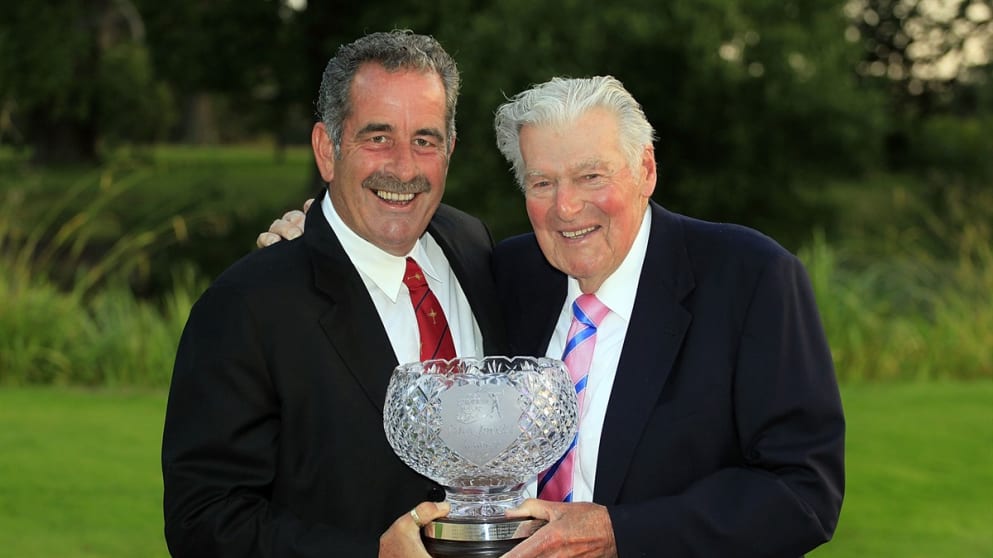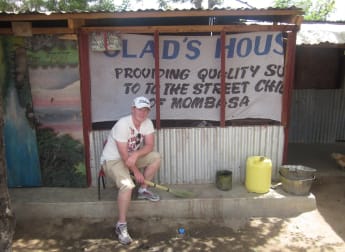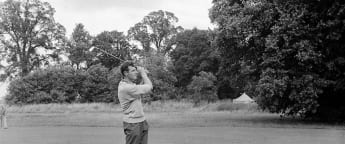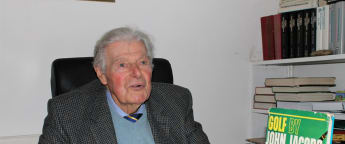To mark the 40th anniversary of the first European Tour event on Thursday April 12, 2012, europeantour.com sat down with its founding father, John Jacobs OBE. In this, the first in a series of features, we look back at the story of struggle in the formative years and the visionary mind that set the ball rolling on the Tour that would take the professional game of golf to the world.

It was the inimitable 19th-century playwright and Irishman Oscar Wilde that once said, “Ambition is the germ from which all growth of nobleness proceeds”, and it seems certain that the face of European golf, as the esteemed global enterprise it is today, would be inherently different were it not for the vision and foresight of one extraordinary man four decades ago.
Now 87 years old, and having lost nothing of the captivating character and formidable presence that has made him such a legendary figure within almost every facet of the game, it is on a late winter’s morning that John Jacobs welcomes us into his home deep in the south of England’s alluring New Forest with a warm and welcoming smile.
Few within golf have had as far-reaching, as all-encompassing an impact on the sport as Jacobs, yet he remains as humble and friendly a man as you could wish to meet, often suffixing fluid and engaging tales of his golfing life with unnecessary apologies for “rambling on” and concerns that he comes across as “boasting awfully”.
But for a man that was made an OBE in the Queen’s New Year Honours list in 1997 before three years later being inducted into the World Golf Hall of Fame, Jacobs’ worries of self-glorification are wholly unwarranted.
A former professional player of note himself, Jacobs played in The 1955 Ryder Cup in California, and was twice a Ryder Cup Captain in 1979 and 1981 – importantly the first two events to feature a continental European Team. Furthermore, he established himself as one of the most highly-regarded golf teachers of all time and – as will be the focus in this segment of the interview’s serialisation – he was the founding father of what would later become The European Tour.
The seeds of the Tour were first laid over half a century ago in Harrogate, England, when in 1954 a then 29 year old Jacobs led the opening charge in what was set to be a 20-plus year battle to revolutionise the sport’s tournament scene.
Jacobs, a strong and sharp-minded Yorkshireman of pure golfing stock, gathered the signatures of 29 tournament players backing a requisition expressing the discontent with the way tournaments were being organised. His petition for change was presented to the club professional-led 28-man PGA Executive Committee that governed the game in Britain at this time.
The content of this memorandum proved, at that time, ineffective, but it would later provide the blueprint upon which The European Tour would develop. In short, it demanded a modernisation of the distribution and size of prize funds; a new vibrancy to attract sponsors and increase awareness; and, crucially, a tournament scene that expanded far beyond the realms of the British Isles.
And at the forefront of the movement from the outset was Jacobs.
Along with a supporting cast of fellow players also backing the call for change in the face of the established and antiquated ways of the Executive Committee, Jacobs was not to be easily dissuaded from his chosen path.
 |
“In the ‘50s and early 60s, myself, Bernard Hunt, Peter Alliss and Harry Weetman were desperately trying to get some life into the tournament scene,” Jacobs recalls “But we were up against this group of people, none of whom were of our generation at all, and they were automatically against the younger guys. I might be overstating it, somewhat, but we couldn’t get anything done.”
By the early 1960s the quartet, led by Jacobs, had finally secured themselves four places on the Executive Committee, an election which, as he puts it, “didn’t do us scant good as it turned out” thanks to the continuing imbalance of the board in favour of the “old guard”.
It was almost a decade later before Jacobs’ plans progressed. He had retired from tournament golf and was Managing Director of Athlon Sports, and was gaining a reputation as a teacher in America. Then David Talbot, Captain of the PGA at the time, and Geoffrey Cotton, Chairman of the PGA, came to Jacobs asking him to take on the Tour. Jacobs initially responded: “Not on your life, I’ve wasted far too much of my time on that years ago.”
Nevertheless the much respected John Bywaters, then Secretary of the PGA and described by Jacobs as a “marvellous guy”, convinced Jacobs that he must take on the role. His words fed the burgeoning root of a united European tournament scene in Jacobs’ mind.
Jacobs recollects: “It was only a little while later that John came to see me and he said, ‘John, you owe this. You’re the one person that can bring this whole thing together’ and he was right. He told me he thought we should go to Europe and he really got me thinking in the right direction.”
Having taught many of the top international sides and golf unions across the continent, Jacobs was, as he puts it, “in good water” with a lot of them and well placed to start negotiations. So it came to pass that after agreeing to take on the job 50 per cent of the time, he took up the role of ‘Tournament Director-General’ on October 1, 1971.
Jacobs, along with a team of Bywaters, George Simms as head of PR and Marina Bray as his secretary, would over the next five years mastermind and mould what became The European Tour. This started with an examination of the prize money structure (at that time there was a scale of prizes one to ten, but 11 to 40 were all the same – “25 quid I might say,” Jacobs quips) and a reassessment of the sponsorship in the game.
“The first three months were fantastic, we were immediately successful,” he says. “The first two weeks I was in the job I actually lost two tournaments because I wrote to all the then sponsors in the most diplomatic way I possibly could, thanking them for their efforts but enthusing that it couldn’t possibly stay the same as the way it was being run because as it was three players made money, five broke even and the rest lost money. It just wasn’t a runner. Therefore I insisted on a minimum tournament prize fund – it sounds stupid now – of £5,000.”
Jacobs lost two sponsors, but gained five! He flipped the position of power between the tournament and sponsor, and by Christmas 1971 he had secured £443,450 in prize money, almost double what had been awarded earlier that year.
Significantly, he also secured, through a European Committee he had established, a “Continental Swing”, embracing the French, German, and Spanish Opens. Indeed the Spanish Open would become the first official European Tour event at Pals Golf Club in Girona on the 12th April 1972. What is more the Jacobs blueprint was being noted not only in the boardrooms of power of leading companies but also by the media. Expanding column inches in national and regional newspapers, encouraged by increasing interest in the game driven by Jacobs providing more opportunity and incentive for the players, gave the sport fresh momentum further fuelled by the decision of ITV to broadcast four tournaments in the UK – unprecedented exposure at the time.
It was, by anyone’s standards, a remarkable start, one that prompted the late Mark McCormack, founder of the International Management Group (IMG), to say: “It may be no more than a slight exaggeration to say that these 12 months saw the Tour progress by a quarter of a century. And that is quite a trick” – a statement Jacobs describes as “wonderful".
 |
Having opened with a theatrical anachronism it is fitting to observe that Jacobs often converses with the embracing tone of one addressing an audience.
His tenor is inclusive and welcoming, his stories compelling and richly endowed with the names of many late, great names from the golf world, while a wavy mane of white hair naturally formed into a widows peak frames a charming and worldly face.
It’s clear the time was one of tension and personal test, though, for Jacobs, and he was at his most serious at these points of our conversation, telling of the many club pros he lost as friends in these tumultuous years.
The most turbulent of which passed between 1973 and 1975, as Colin Snape took over as Secretary of the PGA after the sudden death of Bywaters. The new secretary produced a sensational paper in August of 1973, an extraordinary about-turn seeking to remove power from Jacobs and the Tournament Committee back into the jurisdiction of the PGA, and a statement of intent that would lead to two years of acrimonious conflict between the two parties.
“He was hell-bent on becoming the main man and wanted to get the tournament players completely subservient to his rule,” Jacobs frowns, shaking his head. “This, after we had been so successful in those two years!”
As Laddie Lucas said in his 1987 biography of John Jacobs, the controversial paper “threatened the new breed of tournament players, whose gaze, under their director-general was now fastened on European horizons”.
Jacobs, however, was a shrewd operator. Supported by the indefatigable support of Bray and a new recruit, the 20-something Scottish banking prodigy Ken Schofield, and around 80 tournament professionals, he guided the situation to a zenith at York University in August of 1975.
On the cusp of being fired by the PGA for talking to the press, Jacobs unveiled a knockout blow to make certain his dream of a burgeoning European Tour would come to fruition.
“We had 80 signatures from the players and the PGA had to agree to it. We had won the day,” beams Jacobs. “That meeting was key to our future. Laddie describes it wonderfully in that book.”
Indeed he does, in true golfing parlance, as “a beautifully faded four wood to the stick”.
But in a manner indicative of the man’s magnanimous character, Jacobs never held the whole unpleasant mess against the PGA, enthusing how he convinced the players not to break away completely in the midst of the anguish and frustration.
 |
“I’m so glad I did,” he says. “I assured them I would get us complete autonomy and that was that. I’m hugely proud of the PGA now, they lead the world. If you go to The Belfry now their practice facilities, the messages they put out, and the people who are taught to teach there, they’re the best in the world.”
One gets the sense that no one else could have managed those frustrating, challenging years as Jacobs did. They remain a true testament to his skill, vision and diplomacy.
Perhaps because Jacobs accomplished so much in the formative years of the Tour, it is often forgotten that his tenure as Tournament Director-General was relatively short-lived. By the start of the 1975 season he had handed the reins to Schofield, now supported by George O’Grady and Tony Gray, with a structure in place whereby the tournament players and the club professionals ran their own affairs. Jacobs did so by stressing in his words that this would lead to an atmosphere of co-operation within the PGA, sadly lacking in the past, and the importance of Neil Coles, as the first Chairman of the then Tournament Players’ Division, bringing to bear in Committee the same qualities of quiet authority he so ably exhibits on the golf course.
Thus under Schofield’s stewardship the organisation would flourish over the next thirty years before O’Grady as Chief Executive demonstrated from 2005 his determination and dedication to use the global experience to provide the best for the players and the fans by further enhancing interest in the game and growing The European Tour brand.
“I moved aside because I wanted to get on with my own career but Ken was a natural and I knew the whole business was in safe hands,” he says. “If you look at where the Tour started when Ken took over and where it was when he left, it is almost unbelievable, and George has followed that on by moving things even further forward. Great credit must go to both of them.”
Having started with just a handful of tournaments in 1972 and a total prize fund for that season of just under half a million pounds – itself a stunning figure at that time – The European Tour now traverses every continent on the globe. The 2011 season hosted 52 tournaments across the world with a tournament purse that totalled approaching €150 million.
In Schofield and now O’Grady, Jacobs clearly believes the Tour has importantly always had the right men for the job at the helm, characters of a kindred spirit to that of his own, with vision and skill matching, and even surpassing, his own.
 |
“I couldn’t have ever imagined that it would go on to be played so far afield as it is now,” he admits. “When Ken went initially to Africa (for the Tunisian Open in 1982), at first I couldn’t go with that. I was out of it and I trusted Ken anyway, but European was Europe to me and there aren’t many people of my generation that wouldn’t have said that.
“But thank God he did! We’ve now got a lovely, lovely situation whereby the PGA Tour has the USA and The European Tour has the rest of the world, almost. It makes it an even playing field, doesn’t it? Ken was entirely right. It’s still The European Tour whether you’re playing in the Middle East, Australia, or wherever the hell you’re playing, and that is only continuing apace now under George’s guidance and vision.”
Despite reaching the latter stages of his ninth decade, Jacobs has lost none of the quick wit and humour that has endeared him to so many in his lifetime, and despite admitting he “doesn’t get back up to Yorkshire much”, he still retains a great deal of northern spirit and vivacity.
Having spoken at length about the first 40 years, I ask him where he sees The European Tour in another 30 or 40, to which he replies, quick as you like: “Well we’ll probably have a couple of courses on Mars by then won’t we?” before adding, with a mischievous smile, “Anyway, I’ll be a divot by then, I’ll send you a message.”
Jacobs, out of sheer modesty, constantly talks down his role in the growth of the European game, yet to all outside observers his input and influence is indisputable, and when he is pressed on the defining achievements in his wide-ranging career he finally yields.
And what, he is asked, for a man that has achieved so much and contributed so greatly to golf in his life, from playing to teaching to The Ryder Cup to sculpting the modern architecture of The European Tour, what is the one thing he is most proud of above all others?
“I think the Tour,” he answers with neither thought nor hesitation. “I think The European Tour.
“And yet,” he pauses for a moment as tears begin to form in the corner of his time-wisened eyes, eyes that have overseen so much change in the sport he so dearly cherishes, “I was born into the game. Things just occurred to me.
“I’ve always been proud of it but on the other hand I recognise that things just dropped into my court; the people, the situation, and I’ve got a tremendous amount of credit for it but everything just fell right.”
For the first time that day, the sun breaches the pale grey sky above Jacobs’ home, revealing streaks of pastel blue against the tree-lined Hampshire horizon, and the great man cuts a figure of contentment; satisfied with his achievements, a man whose ambition and vision helped the noble game grow far beyond what even he could ever have envisaged all those years ago.
“I wanted to be the best golfer there’d ever been,” he says, a caesura lingering in the air dramatically, musically. “I’m not sorry I wasn’t.”
Over the next few weeks leading up to the Reale Seguros Open de España – the event which launched the fledgling European Tour 40 years ago - europeantour.com will be continuing with our series on John Jacobs as his interview looks back at his time as a player, coach and the Ryder Cup Captain. Next week we’ll bring you an insight into John Jacobs – the player.
Feature by Will Pearson








